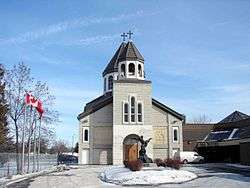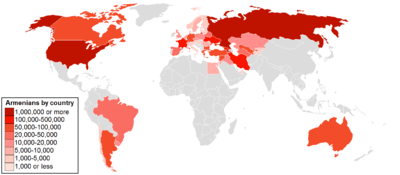Armenian Canadians
| Total population | |
|---|---|
| 55,740 (2011),[1] estimation up to 100,000[2] | |
| Regions with significant populations | |
|
| |
| Languages | |
| Armenian (mainly Western Armenian with a minority of Eastern Armenian), Canadian English, Canadian French | |
| Related ethnic groups | |
| Other Armenians and Armenian diaspora |
Armenian Canadians (Armenian: կանադահայեր, kanadahayer) are Canadian citizens of Armenian national background or descent. The 2006 census determined that their number was 50,500[3] and 30,130 had Armenian as their mother tongue.[4] A large part of the Armenian diaspora in Canada came from nations in the Middle East and some from Europe.[5] Canada has also seen increased immigration from Armenia, especially after the collapse of the Soviet Union.
History
During the late 19th and early 20th centuries, Armenians who had escaped persecution from the Armenian Genocide settled in communities in southern Ontario. Early immigrants congregated in kratarans or reading rooms where Armenian Canadians shared Armenian literature.[6]
Thousands of Armenians made their way to Canada after federal immigration policies became less restrictive during the 1950s. Many newcomers were originally from Middle Eastern countries that were affected by strife such as Egypt, Iran, Lebanon, Syria and Turkey. In the early 1990s, some Armenians immigrated to Canada after the disintegration of the Soviet Union. Since 2015, as a result of the Syrian Civil War, thousands of ethnic Armenians from Syria are coming to Canada.[7]
Most Armenian-Canadians are centered in the provinces of Quebec and Ontario and are active in community life. Smaller communities exist in the central and Maritime Provinces, with a slightly larger community in British Columbia.
Communities
Montreal and Laval
Montreal, numbering 23,970 people of Armenian ancestry,[1] is center for two Armenian Apostolic (Orthodox) prelacies governing not just Montreal community but all Armenian Apostolic (Orthodox) communities throughout Canada:
- Diocese of the Armenian Church of Canada (representing the See of Holy Echmiadzin)
- Armenian Prelacy of Canada (representing the Holy See of Cilicia)
- Parishes: Sourp Hagop Cathedral (Montreal) and Sourp Kevork Armenian Apostolic Church (Laval)

There is also the Notre Dame de Nareg Armenian Catholic Church (in Ville Saint Laurent suburb of Montreal) and various Armenian Evangelical Churches, most notably the First Armenian Evangelical Church (Montreal) and the Armenian Evangelical Church (Laval).
The Armenian community in Montreal has two full-time Armenian schools, the Sourp Hagop Armenian School and the Armén-Québec Alex Manoogian School. Laval is the home of the Armenian Catholic Ecole Notre-Dame de Nareg School.
Montreal also boasts the publication of two long-running pan-Canadian Armenian weeklies, Abaka that debut in 1975 and Horizon that started in 1979. Both weeklies are in fact trilingual, as in addition to their Armenian-language content, they run English and French special sections as well on a weekly basis. Horizon Weekly also publishes a monthly literary supplement as well as a monthly youth supplement in addition to the annual New Year's edition.
Montreal also has a monument in remembrance of the victims of the genocide. The monument also serves as a memorial to all peoples who are victims of genocide. It is located in Parc Marcelin-Wilson in the Ahuntsic district of Montreal.
Toronto

The Armenian community in Toronto, with a 2011 population figure of 17,795,[1] is centered in the neighborhoods of Don Valley Village and Pleasant View in north-central Toronto. The hub of the community is the Armenian Community Centre of Toronto complex at Victoria Park and 401.
From its beginnings in the early 1960s, the Armenian Community Centre of Toronto has been the hub of the Toronto-Armenian community since 1979. The grounds of the Armenian Community Centre are also home to the A.R.S. Armenian School (which offers nursery, kindergarten, elementary and secondary level education), St. Mary Armenian Apostolic Church and the Armenian Youth Centre, which house several community organizations such as the Armenian Relief Society, Homenetmen Armenian General Athletic and Scouting Union, Hamazkayin Armenian Cultural and Educational Society, the Armenian National Committee of Canada, the Armenian Youth Federation, Armen Karo Student Association, the A.R.F. Junior Organization of Canada and the Armenian Senior Citizens Club.
Armenian Apostolic churches include Holy Trinity Armenian Church (Diocese of the See of Holy Echmiadzin) and St. Mary Armenian Apostolic Church (in Willowdale, pertaining to the diocese of the Holy See of Cilicia)
St. Mary Armenian Apostolic Church airs a weekly Armenian radio show every Sunday from 8pm to 11pm on 1690am, named The Voice of Giligia.[8]
Armenian Catholics have their own church St. Gregory the Illuminator in Toronto. Toronto Hye, an Armenian-related periodical is published monthly by the community.
Ottawa
With a small thriving Armenian community of 1,425,[1] Canada's capital city is the home of the St. Mesrob Armenian Apostolic Parish.
Other Ontario regions
Due to the growth of the Armenian community, many have established outside the Greater Toronto Area. Present day communities are present throughout the province in Mississauga, St. Catharines, Hamilton, Windsor and Cambridge, numbering roughly 6,000 Armenians.[3]
Parishes under the diocese of the See of Holy Echmiadzin include St Vartan in Mississauga, St. Gregory the Illuminator in St. Catharines, St. Mary in Hamilton and Holy Resurrection in Windsor. Parishes under the diocese of the Holy See of Cilicia include St. Nishan in Cambridge and St. Paul in St. Catharines.
Vancouver
The community, which had 2,705 people of Armenian ancestry per the results of the 2011 Canada Census,[1] has its own Armenian Apostolic Churches: St Vartan Armenian Church (diocese to the See of Holy Echmiadzin) and St. Greogory the Illuminator (in Richmond, pertaining to the diocese of the Holy See of Cilicia). The diversity of the Armenians in Vancouver, BC ranges from those that immigrated from Iran, Syria, Iraq, Lebanon and even Turkey. The community recently (2014) inaugurated the Armenian Genocide Memorial, which commemorates and was dedicated to the first Genocide of the 20th century, April 24, 1915.
Notable Armenian Canadians
See also
References and notes
- 1 2 3 4 5 Statistics Canada. "2011 National Household Survey: Data tables". Retrieved 28 January 2015.
- ↑ Embassy of the Republic of Armenia in Canada.
- 1 2 Statistics Canada, 2006 Census, Ethnic Origin (247), Single and Multiple Ethnic Origin Responses (3) and Sex (3) for the Population of Canada, Provinces, Territories, Census Metropolitan Areas and Census Agglomerations, 2006 Census - 20% Sample Data, 97-562-XCB2006006
- ↑ Statistics Canada, 2006 Census, Detailed Mother Tongue (103), Knowledge of Official Languages (5), Age Groups (17A) and Sex (3) for the Population of Canada, Provinces, Territories, Census Divisions and Census Subdivisions, 2006 Census - 20% Sample Data, 97-555-XCB2006016
- ↑ Canadian Encyclopedia article on "Armenians" Archived September 30, 2007, at the Wayback Machine.
- ↑ Kaprielian, Isabel (Spring–Summer 1982). "Armenian political press and its reading rooms". Polyphony: The Bulletin of the Multicultural History Society of Ontario. 4 (1): 30. Retrieved 2 August 2013.
- ↑ Syrian refugees get warm welcome at Armenian community centre
- ↑ the Voice of Giligia
External links
General
- Abaka Weekly Newspaper
- Horizon Weekly Newspaper
- Armenian Community Centre of Toronto, Ontario
- Armenian National Committee of Canada
- Tekeyan Cultural Union - Montreal
- Audio file about Montreal Armenians, in French
Religious links:
- Diocese of the Armenian Apostolic Church (of the See of Holy Echmiadzin)
- Armenian Prelacy of Canada (of the Holy See of Cilicia)
- Armenian Catholic Notre-Dame de Nareg Parish in Montreal
- St. Gregory the Illumiator Armenian Catholic Church in Toronto
- First Armenian Evangelical Church of Montreal
